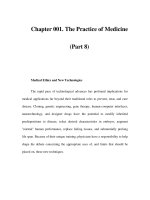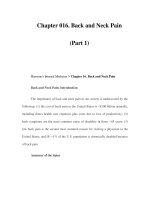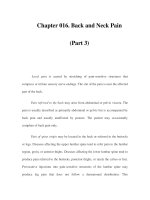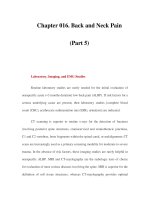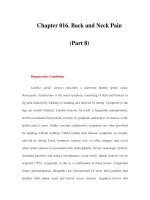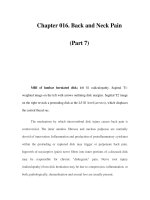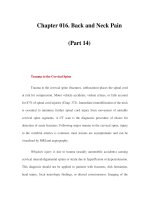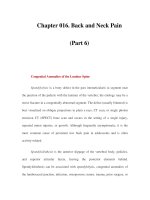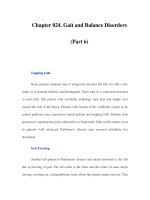Chapter 045. Azotemia and Urinary Abnormalities (Part 8) pps
Bạn đang xem bản rút gọn của tài liệu. Xem và tải ngay bản đầy đủ của tài liệu tại đây (12.38 KB, 5 trang )
Chapter 045. Azotemia and
Urinary Abnormalities
(Part 8)
Approach to the patient with polyuria. ATN, acute tubular necrosis; ADH,
antidiuretic hormone
Excessive filtration of a poorly reabsorbed solute such as glucose,
mannitol, or urea can depress reabsorption of NaCl and water in the proximal
tubule and lead to enhanced excretion in the urine. Poorly controlled diabetes
mellitus with glucosuria is the most common cause of a solute diuresis, leading to
volume depletion and serum hypertonicity. Since the urine Na concentration is
less than that of blood, more water than Na is lost, causing hypernatremia and
hypertonicity. Common iatrogenic solute diuresis occurs from mannitol
administration, radiocontrast media, and high-protein feedings (enterally or
parenterally), leading to increased urea production and excretion. Less commonly,
excessive Na loss may occur from cystic renal diseases, Bartter's syndrome, or
during the course of a tubulointerstitial process (such as resolving ATN). In these
so-called salt-wasting disorders, the tubule damage results in direct impairment of
Na reabsorption and indirectly reduces the responsiveness of the tubule to
aldosterone. Usually, the Na losses are mild, and the obligatory urine output is <2
L/d (resolving ATN and postobstructive diuresis are exceptions and may be
associated with significant natriuresis and polyuria).
Formation of large volumes of dilute urine represent polydipsic states or
diabetes insipidus. Primary polydipsia can result from habit, psychiatric disorders,
neurologic lesions, or medications. During deliberate polydipsia, extracellular
fluid volume is normal or expanded and plasma vasopressin levels are reduced
because serum osmolality tends to be near the lower limits of normal.
Central diabetes insipidus may be idiopathic in origin or secondary to a
variety of hypothalamic conditions including posthypophysectomy or trauma or
neoplastic, inflammatory, vascular, or infectious hypothalamic diseases. Idiopathic
central diabetes insipidus is associated with selective destruction of the
vasopressin-secreting neurons in the supraoptic and paraventricular nuclei and can
be inherited as an autosomal dominant trait or occur spontaneously. Nephrogenic
diabetes insipidus can occur in a variety of clinical situations as summarized in
Fig. 45-4.
A plasma vasopressin level is recommended as the best method for
distinguishing between central and nephrogenic diabetes insipidus. Alternatively,
a water deprivation test plus exogenous vasopressin may also distinguish primary
polydipsia from central and nephrogenic diabetes insipidus.
For a detailed discussion, see Chap. 334.
Further Readings
Anderson S et al: Renal and systemic manifestations of glomerular disease,
in Brenner & Rector's The Kidney, 7th ed, BM Brenner (ed). Philadelphia,
Saunders, 2004, pp 1927–1954
Berl T, Verbalis J: Pathophysiology of water metabolism, in Brenner &
Rector's The Kidney, 7th ed, BM Brenner (ed). Philadelphia, Saunders, 2004, pp
857–920
Kasiske BL, Keane WF: Laboratory assessment of renal disease:
Clearance, urinalysis and renal biopsy, in Brenner & Rector's The Kidney, 7th ed,
BM Brenner (ed). Philadelphia, Saunders, 2004, pp 1107–1150
Khadra MHet al: A prospective analysis of 1,930 patients with hematuria to
evaluate current diagnostic practice. J Urol 163:524, 2000 [PMID: 10647670]
Rodrigo E et al: Measurement of renal function in pre-ESRD patients.
Kidney Int Suppl 80:11, 2002 [PMID: 11982806]
Sasaki S: Nephrogenic diabetes insipidus: Update of genetic and clinical
aspects. Nephrol Dial Transplant 19:1351, 2004 [PMID: 15004257]
Shrier RW et al: Acute renal failure: Definitions, diagnosis, pathogenesis
and therapy. J Clin Invest 114:5, 2004
